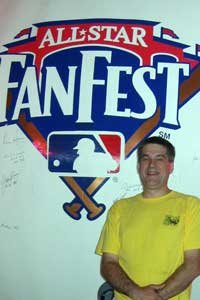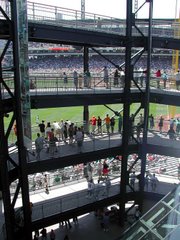The last act of Gen. William D. Eckert before he was ousted as baseball commissioner in late 1968 was to approve a few measures to give batters a better shot at actually hitting the ball.
The powers that be were concerned because of the paucity of runners crossing the plate in what has come down in history as the Year of the Pitcher. Fans who like plenty of offense must have been put off by some of these occurrences in '68:
• The earned run average was a hair under 3. That's for the major leagues as a whole. Any pitcher not in the 1's or 2's wasn't earning his paycheck.
• The National League's cumulative batting average was .243, which looks good next to the pre-DH American League's mark of a robust .230.
• Carl Yastrzemski led the AL with a .301 average. As late as Sept. 13, he was in the top spot at sub-.300.
• The Yankees - yes, the 20-time (to that point) World Champions - hit .214 as a team. Mickey Mantle, at .237 in his final season, was one of the team's better hitters.
• The Tigers managed to win the World Series despite a regular third baseman, Don Wert, who hit .200 in 536 at bats, and a regular-enough shortstop, Ray Oyler, at .135. One of the reasons the Tigers won the Series was that manager Mayo Smith had inspiration to stick slick-fielding outfielder Mickey Stanley at shortstop for the seven games to get some semblance of a bat in there.
• The Mets brought pitcher Jim McAndrew up from the minors and failed to score a single run in any of his first four starts. (See previous mini-research project.)
The list of terrible batting feats could go on for a while, but one hitter still is in the record books for his accomplishments in '68. Frank Howard, the massive first baseman for the Washington Senators, went on a tear starting May 12 that is unparalleled in baseball history. He hit two home runs off the Tigers at D.C. Stadium (Robert F. Kennedy still was alive for a few more weeks) and followed that up two days later with a pair more in Fenway Park. He added another on May 15 in Boston before the Senators traveled to Cleveland, where Howard hit two out of Municipal Stadium on May 16. For some reason, the Senators played the next night in Detroit, and Howard homered again. Two more dingers on May 18 gave Frank a total of 10 in six games, in four different cities.
But if baseball fans talk about 1968, three names come to the forefront:
• Don Drysdale, who between May 14 and June 4 threw six consecutive complete-game shutouts on his way to a then-record streak of 58 2/3 straight scoreless innings. As a side note, the late Mr. Drysdale (who lent his name to the corresponding character on "The Beverly Hillbillies") won only 12 more games for his career after the streak was broken.
• Denny McLain, who at age 24 became the only pitcher since the '30s to win 30 for a season (and pitched his way out of the majors just four years later).
• Bob Gibson, whose 1.12 ERA was a phenomenal accomplishment even by Year of the Pitcher standards.
I remember watching Gibson pitch toward the end of his career, and even then he still could bring it. But he was as close to untouchable in '68 as any pitcher ever seems to have been.
Somehow, the Cardinals' offense managed to sputter its way to losing nine games while Gibson was on the mound. But some of the rest of his statistics defy belief, especially compared with the current standards of so-called pitching "excellence": 28 complete games in 34 starts, 13 of which were shutouts, and 304 2/3 innings for an average of - get this! - 8.97 innings per start. The category of "Quality Start" (3 or fewer earned runs allowed in six or more innings) hadn't been invented yet, but retroactively Gibson logged 32 of 'em, missing only on Aug. 4 while hurling 11 innings in an eventual loss to the Cubs and Sept. 11, when he beat the Dodgers for his 21st victory.
Then there was his performance in the World Series. He struck out a record 17 Tigers in his 4-0 opening win over McLain, then followed up with 10 K's in a 10-1 rout in Game Four, which marked his seventh consecutive complete-game victory in Series competition (yet another mark that will stand for the ages). Some shoddy fielding helped cost him the decisive seventh game, but he finished the Series with 35 strikeouts and just four walks in 27 innings.
Perhaps Gibson's most remarkable accomplishment of 1968 took place during the games he pitched in June and July.
On June 2, he gave up a home run to the Mets' Ed Charles to lead off the seventh inning in a game the Cardinals won, 6-3. In that Aug. 4 game, the Cubs touched Gibson up for a pair of runs in the fifth inning.
In between, he hurled 106 innings. During that span, he surrendered a grand total of three runs, all earned, for an ERA of 0.25. He won 12 straight, all complete games, and eight of those were shutouts. If it hadn't been for the Dodgers' Len Gabrielson scoring on a wild pitch on July 1, Gibson would have broken Drysdale's recently established mark for consecutive shutouts; by coincidence, Drysdale was Gibson's mound opponent that day.
After Charles' blast, Gibson didn't surrender another home run until Aug. 4, when future Hall of Famer Billy Williams took him deep.
Following his 7-1 win at Shea Stadium on July 30, Gibson had an ERA of 0.96. It dipped under 1 again as late as Sept. 2, when he pitched a 10-inning, 1-0 shutout vs. baseball's best-hitting team of '68, the Reds.
His overall performance that season earned him not only the Cy Young Award, but he also was named Most Valuable Player. He remains the last National League starting pitcher to capture the honor.
And that's another feat that is likely not to occur again.
Trivia question 47 (courtesy of SABR's Bruce Brown): Who is the only catcher to lead the American League in triples?
Showing posts with label Bob. Show all posts
Showing posts with label Bob. Show all posts
Thursday, July 5, 2007
Thursday, June 14, 2007
The unfortunate Mr. Groom

In the list of no-hitters against pennant-winning teams (and their rough equivalents), I mentioned Bob Groom as having pitched one against the White Sox in 1917, and that Mr. Groom seemed to be a pretty good hurler who got stuck on some bad teams.
I received an e-mail from Catherine Groom Petroski, Bob's granddaughter, who plans to give a presentation about him at the annual convention of the Society for American Baseball Research, July 26-29 in St. Louis. I wrote back that I'd love to attend, but I'm waiting until next year, when the convention is just up the road in Cleveland.
At any rate, Mrs. Petroski mentioned, "In the material I’ve amassed for the biography I’m writing, I would have to agree that BG’s teams were not, all around, very good, except for the 1912 and 1913 Senators."
The record shows that Groom, indeed, had his best season in 1912, when the traditionally lowly Senators rallied behind Bob and another pitcher named Walter Johnson to rise all the way to second place. Groom won 24 games that year, with a 2.62 earned run average.
His ERA rose the following year, and his record leveled out at 16-16. Perhaps seeing the opportunity for something better, he signed with the St. Louis Terriers when the Federal League achieved brief status as a major league in 1914. The Terriers turned out to be the doormats of the FL, though, and poor Bob lost 20 games. St. Louis jumped to second place in 1915, and Groom improved to 11-11, but the Federal League went out of business after the season and his contract was acquired by the St. Louis Browns.
He did OK in '16 (13-9, 2.57 ERA) as the Browns finished fifth, but as St. Louis took a nosedive to seventh in '17, so did Groom. The no-hitter was pretty much his last hurrah in a career that probably could have been much better.
If you're going to be in St. Louis for the SABR convention, Mrs. Petroski's presentation is at 12:30 p.m. on the event's opening day.
SABR has an ongoing Baseball Biography Project, and the latest entry is Jose Morales, whom I remember as a great pinch-hitter who burned my favorite team at the time, the Phillies on quite a few occasions in the '70s.
Click here to read the biography by Rory Costello, who is an expert on major-leaguers who hailed from the Virgin Islands.
Trivia question 38: Jose Morales set a major-league record with 25 pinch-hits in a season. Who now holds the mark with 28?
Subscribe to:
Posts (Atom)








